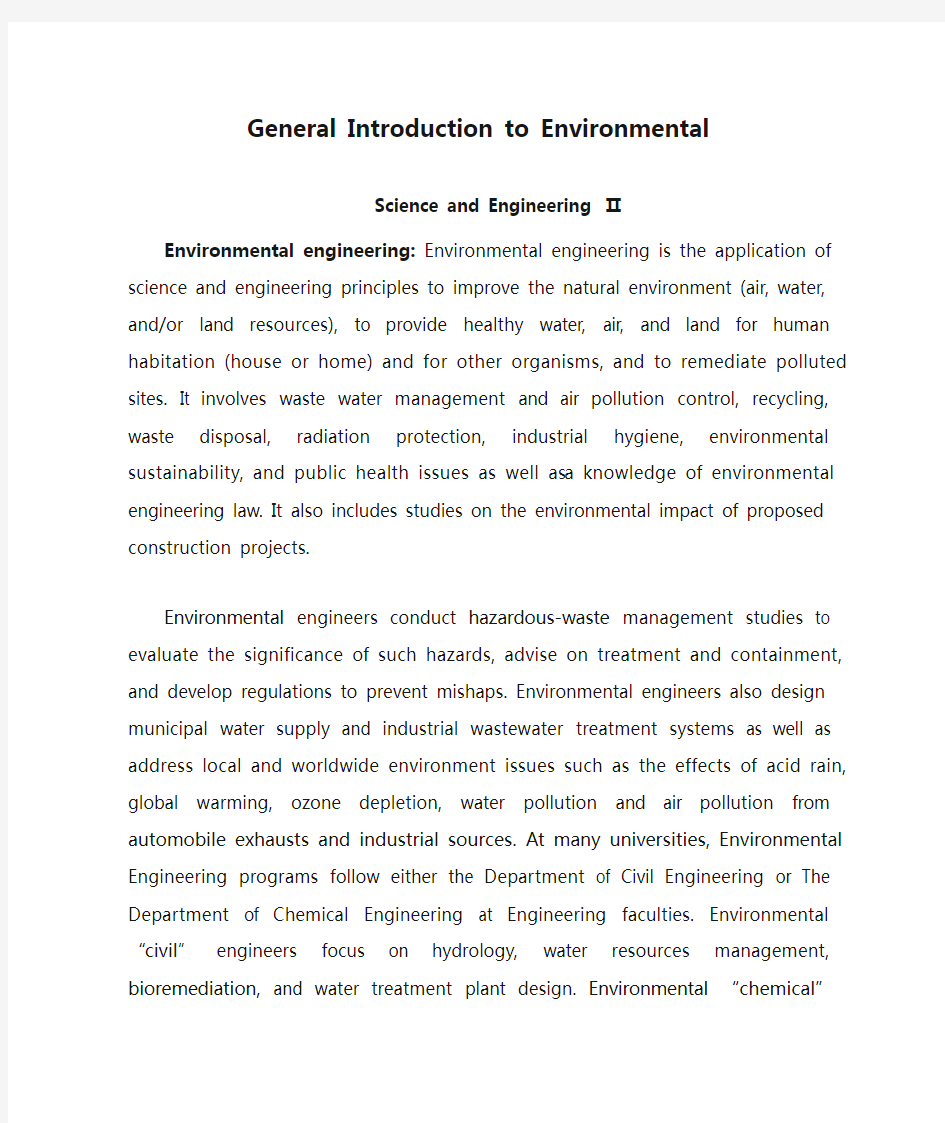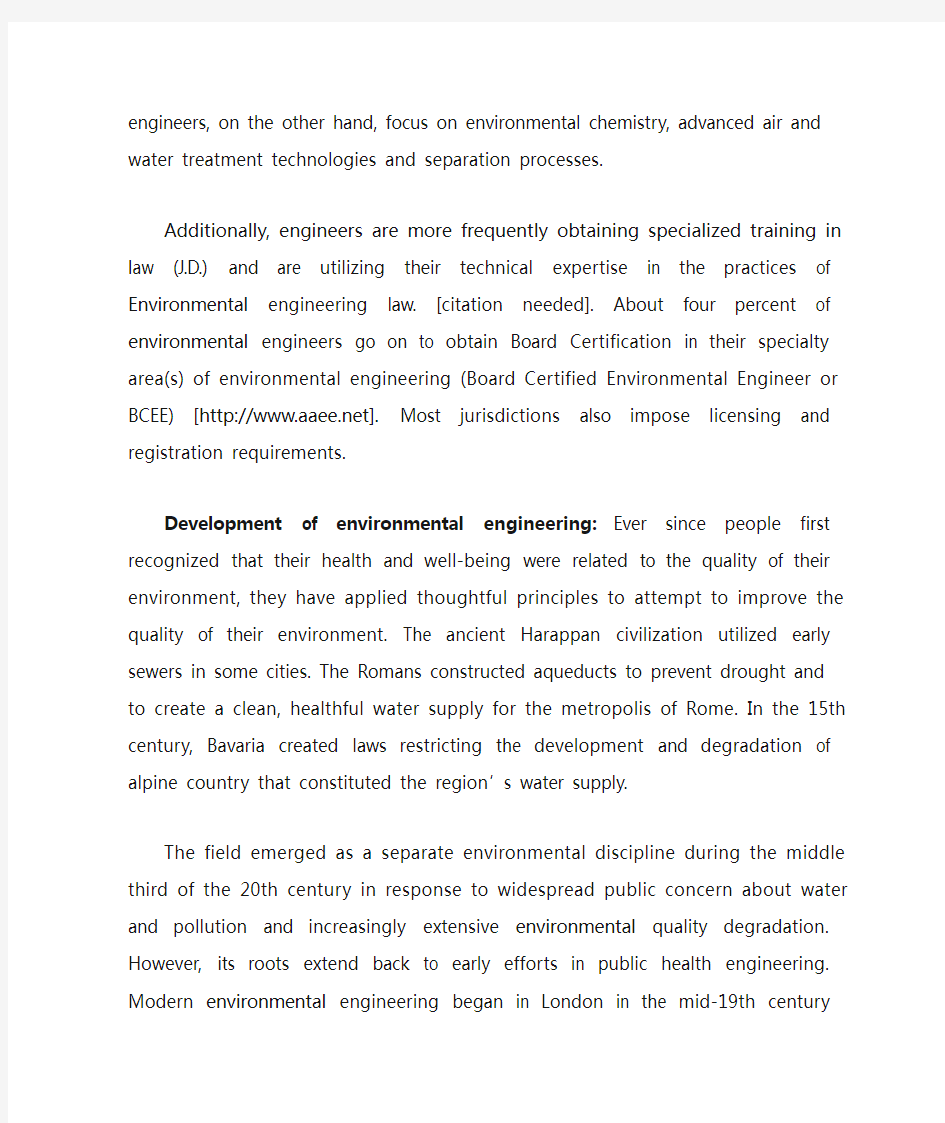Unit1 General Introduction to Environmental Science and Engineering Ⅱ


General Introduction to Environmental
Science andEngineering Ⅱ
Environmental engineering:Environmental engineering is the application of science and engineering principles to improve the natural environment (air, water, and/or land resources), to provide healthy water, air, and land for human habitation (house or home) and for other organisms, and to remediate polluted sites.It involves waste water management and air pollution control, recycling, waste disposal, radiation protection, industrial hygiene, environmental sustainability, and public health issues as well as a knowledge of environmental engineering law.It also includes studies on the environmental impact of proposedconstruction projects.
Environmental engineersconducthazardous-waste management studies to evaluate the significance of such hazards, advise on treatment and containment, and develop regulations to prevent mishaps.Environmental engineers also design municipal water supply and industrial wastewater treatment systems as well as addresslocal and worldwideenvironment issues such as the effects of acid rain, global warming,ozone depletion, water pollution and air pollution from automobile exhausts and industrial sources. Atmany
universities, Environmental Engineering programs follow either theDepartment of Civil Engineering or The Department of Chemical Engineering atEngineering faculties. Environmental “civil” engineers focus on hydrology, water resources management,bioremediation, and water treatment plant design. Environmental “chemical”engineers, on the other hand, focus on environmental chemistry, advanced air and water treatment technologies and separation processes.
Additionally,engineers are more frequently obtaining specialized training in law (J.D.)and are utilizing their technical expertise in the practices of Environmental engineering law.[citation needed].About four percent of environmental engineers go on to obtain Board Certification in their specialty area(s) of environmental engineering (Board Certified Environmental Engineer or BCEE) [https://www.360docs.net/doc/943987941.html,].Most jurisdictions also imposelicensing and registration requirements.
Development of environmental engineering:Ever since people first recognized that their health and well-being were related to the quality of their environment,they have applied thoughtful principles to attempt to improve the quality of their environment.The ancient Harappan civilization utilized early sewers in some cities.The Romans constructedaqueducts to prevent drought and to
create a clean,healthful water supply for the metropolis of Rome.In the 15th century,Bavaria created laws restricting the development and degradation of alpine country that constituted the region’s water supply.
The field emerged as a separate environmental discipline during the middle third of the 20th century in response to widespread public concern about water and pollution and increasingly extensive environmental quality degradation.However,its roots extend back to early efforts in public health engineering.Modern environmental engineering began in London in the mid-19th century when Joseph Bazalgette designed the first major sewerage system that reduced the incidence of waterborne diseases such as cholera.The introduction of drinking water treatment and sewage treatment in industrialized countriesreduced waterborne diseases from leading causes of death to rarities.
In many cases, as societies grew, actions that were intended to achieve benefits for those societies had longer-term impacts which reduced other environmental qualities. One example is the widespread application of DDT to control agricultural pests in the years following World War Ⅱ. While the agricultural benefits were outstanding and crop yields increased dramatically, thus reducing world hunger substantially, and malaria was controlled better than it
ever had been, numerous species were brought to the verge of extinction due to the impact of the DDT on their reproductive cycles. The story of DDT as vividly told in Rachel Carson’ s“Silent Spring” is considered to be birth of the modern environmental movement and the dev elopment of the modern field of “environmental engineering”.
Conservation movements and laws restricting public actions that would harm the environment have been developed by various societies for millennia.Notable examples are the laws decreeing the construction of sewers in London and Paris in the 19th century and the creation of the U.S. national park system in the early 20th century.
Scope of Environmental Engineering:Briefly speaking, the main task of environmental engineers is to protect public health by protecting (from further degradation), preserving (the present condition of), and enhancing the environment. Environmental engineering is the application of science and engineering principles to the environment. Some consider environmental engineering to include the development of sustainable processes. There are several divisions of the field of environmental engineering.
Environmentalimpact assessment and mitigation: In this division, engineers and scientists use a systemic identification and
evaluation process to assess the potential impacts of a proposed project, plans, programs, policies, or legislative actions upon the physical-chemical, biological, cultural, and socioeconomic components on environmental conditions. They apply scientific and engineering principles to evaluate if there are likely to be any adverse impacts to water quality, air quality, habitat quality, flora and fauna, agricultural capacity, traffic impacts, social impacts, ecological impacts, noise impacts, visual (landscape) impacts, etc. If impacts are expected, they then develop mitigation measures to limit or prevent such impacts. An example of a mitigation measure would be the creation of wetlands in a nearby location to mitigate the filling in of wetlands necessary for a road development if it is not possible to reroute the road.
The practice of environmental assessment was initiated on January 1, 1970, the effective date of the National Environmental Policy Act (NEPA) in the United States. Since that time, more than 100 developing and developed nations either have planned specific analogous laws or have adoptedprocedure used elsewhere. NEPA is applicable to all federal agencies in the United States.
Watersupplyandtreatment:Engineersandscientistsworktosecu rewatersuppliesforpotableandagriculturaluse.Theyevaluatethewaterb alancewithinawatershedanddeterminetheavailablewatersupply,thewat
erneededforvariousneedsinthatwatershed,theseasonalcyclesofwaterm ovementthroughthewatershedandtheydevelopsystemstostore,treat,an dconveywaterforvarioususes.Wateristreatedtoachievewaterqualityobj ectivesfortheenduses.Inthecaseofpotablewatersupply,wateristreatedto minimizetheriskofinfectiousdiseasetransmission,theriskofnoninfectio usillness,andtocreateapalatablewaterflavor.Waterdistributionsystems aredesignedandbuilttoprovideadequatewaterpressureandflowratesto meetvariousend-userneedssuchasdomesticuse,firesuppression,andirri gation.
Wastewater conveyance and treatment:Mosturbanandmanyruralareasnolongerdischargehumanw astedirectlytothelandthroughouthouse,septic,and/orhoneybucket systems,butratherdepositsuchwasteintowater and conveyitfromhouseholdsviasewersystems. Engineersandscientistsdevelopcollectionandtreatmentsystemstocarry thiswastematerialawayfromwherepeopleliveandproducethewasteand dischargeitintotheenvironment.Indevelopedcountries, substantialresourcesareappliedtothetreatmentanddetoxificationofthis wastebeforeitisdischargedintoariver,
lake,oroceansystem.Developingnationsarestrivingtoobtaintheresourc estodevelopsuchsystemssothatcanimprovewaterqualityintheirsurface watersandreducetheriskofwater-borneinfectiondisease.
Therearenumerouswastewatertreatmenttechnologies.Awastewat ertreatmenttraincanconsistofaprimaryclarifiersystemtoremovesolidan dfloatingmaterials,asecondarytreatmentsystemconsistingofanaeration basinfollowedbyflocculationandsedimentationoranactivatedsludgesy stemandasecondaryclarifier,atertiarybiologicalnitrogenremovalsyste m,andafinaldisinfectionprocess.Theaerationbasin/activatedsludgesyst emremovesorganicmaterialbygrowingbacteria(activated sludge).Thesecondaryclarifierremovestheactivatedsludgefromthewat er.Thetertiarysystem, althoughnotalwaysincludedduetocosts,isbecomingmoreprevalenttore movenitrogenandphosphorusandtodisinfectthewaterbeforedischarget oasurfacewaterstreamoroceanoutfall.
Air quality management:Engineersapplyscientificandengineeringprinciplestoth edesignofmanufacturingandcombustionprocessestoreduceairpollutan temissionstoacceptablelevels.Scrubbers,electrostaticprecipitators,cat alyticconverters,andvariousotherprocessesareutilizedtoremoveparticu latematter,nitrogenoxides,sulfuroxides,volatileorganiccompounds(V OC),reactiveorganicgases(ROG)andotherairpollutantsfromfluegasesa ndothersourcespriortoallowingtheiremissiontotheatmosphere.
Scientistshavedevelopedairpollutiondispersionmodelstoevaluate theconcentrationofapollutantatareceptorortheimpactonoverallairquali
tyfromvehicleexhaustsandindustrialfluegasstackemissions.Tosomeex tent,thisfieldoverlapsthedesiretodecreasecarbondioxideandothergreen housegasemissionsfromcombustion processes.
Other applications:
●Environmentalpolicyandregulationdevelopment
●Contaminated land management and site remediation
●Environment, Health and Safety
●Hazardous waste management
●Natural resource management
●Noise pollution
●Risk assessment
●Solid waste management
EducationofEnvironmentalEngineering:Coursesaimedatdeve lopinggraduateswithspecificskillsinenvironmentalsystemsorenviron mentaltechnologyarebecomingmorecommonandfallintothreebroadscl asses:
EnvironmentalEngineeringorEnvironmentalSystems-courseorie ntedtowardsacivilengineeringapproachinwhichstructuresandthelands capeareconstructedtoblendwithorprotecttheenvironment;Environmen talchemistry,sustainablechemistryorenvironmentalchemicalengineeri ng-coursesorientedtowardsunderstandingtheeffects(goodandbad)ofch emicalsintheenvironment.Suchawardscanfocusonminingprocesses,po
llutantsandcommonlyalsocoverbiochemicalprocesses;Environmental technology-courseorientedtowardsproducingelectronicorelectricalgra duatescapableofdevelopingdevicesandartefactsabletomonitor,measur e,modelandcontrolenvironmentalimpact,includingmonitoringandman agingenergygenerationfromrenewablesources.
